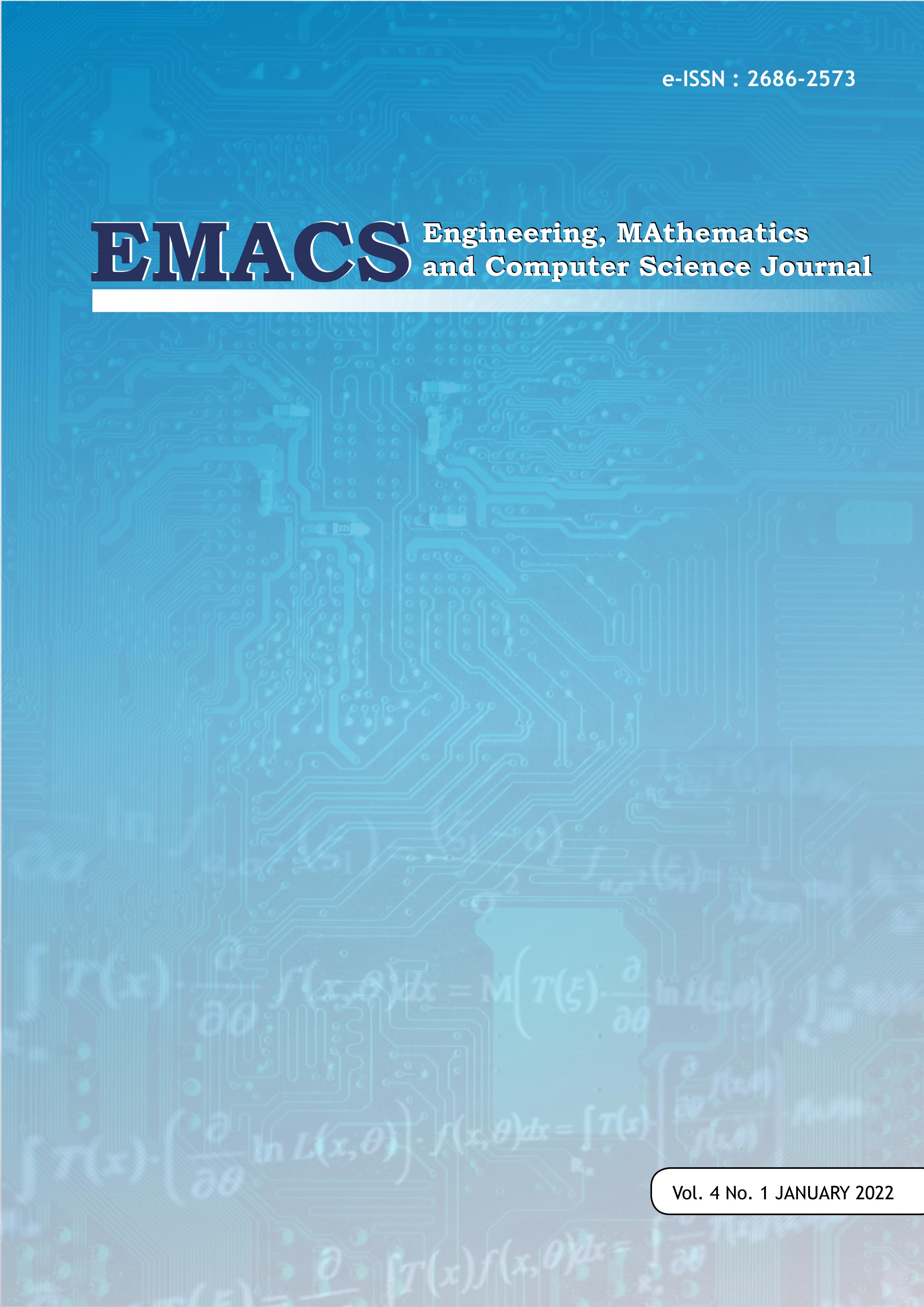Safe-Deposit Box Using Fingerprint and Blynk
DOI:
https://doi.org/10.21512/emacsjournal.v4i1.8080Keywords:
Arduino Uno, Fingerprint, ESP8266, Blynk, IoTAbstract
The criminal act of robbery really makes people nervous, especially in urban areas. There are many ways that can be done to avoid robbery at home and office, such as increasing the security system in the house to protect valuables. Safe-deposit boxes are items that are used to store valuables. Safe-deposit box is used to prevent against theft who want to take valuable things. To increase security, technology has begun to develop for security in various ways, such as fingerprints, passwords, and buzzers. This research will focus on a safe security system using a fingerprint that is connected to the internet with the Blynk application so that the user will get a safe notification when the servo condition is open or closed. The fingerprint sensor is an access to open doors, the Arduino Uno microcontroller is a storage for command logic on the system, the stepper motor acts as an activator for opening and closing servo and the Esp8266 module as a Wi-Fi module that connects equipment components using the internet network with the Blynk application which is used as distance control and notification of incoming access to homes with the concept of Internet of Things (IoT).
References
Alsayaydeh, J. A. J., Khang, A. W. Y., Indra, W. A., Pusppanathan, J. B., Shkarupylo, V., Zakir Hossain, A. K. M., & Saravanan, S. (2019). Development of vehicle door security using smart tag and fingerprint system. International Journal of Engineering and Advanced Technology, 9(1), 3108–3114. www.scopus.com
Al-Shareefi, N. A., Abbas, S. A., Alkhazraji, M. S., & Sakran, A. A. (2021). Towards secure smart cities: design and implementation of smart home digital communication system. Indonesian Journal of Electrical Engineering and Computer Science, 21(1), 271–277.
Hakim, L., & Manurung, B. (2020). Design and analytical simulation of heart rate measurement and human body temperature with linear regression approach. AIP Conference Proceedings, 2221(1), 100002. https://doi.org/10.1063/5.0003189
Hamas, A., Muneer, A., & Fati, S. M. (2021). Smart security door system using SMS based energy harvest. International Journal of Electrical & Computer Engineering (2088-8708), 11(4).
Hoque, M. A., & Davidson, C. (2019). Design and Implementation of an IoT-Based Smart Home Security System. International Journal of Networked and Distributed Computing, 7(2), 85–92. https://doi.org/10.2991/ijndc.k.190326.004
Lee, J., Kim, T. W., Lee, C., & Koo, C. (2021). A scalable platform for investigating the space-specific features of the temporal energy usage pattern and saving potential with real-time bigdata. Journal of Cleaner Production, 314, 128028. https://doi.org/https://doi.org/10.1016/j.jclepro.2021.128028
Mispan, M. S., Jidin, A. Z., Kamaruddin, M. R., & Nasir, H. M. (2022). Lightweight hardware fingerprinting solution using inherent memory in off-the-shelf commodity devices. Indonesian Journal of Electrical Engineering and Computer Science, 25(1), 105–112. www.scopus.com
Najib, A., Munadi, R., & Karna, N. B. A. (2021). Security system with RFID control using E-KTP and internet of things. Bulletin of Electrical Engineering and Informatics, 10(3), 1436–1445. https://doi.org/10.11591/eei.v10i3.2834
Nguyen, B., Goto, B., Selker, J. S., & Udell, C. (2021). Hypnos board: A low-cost all-in-one solution for environment sensor power management, data storage, and task scheduling. HardwareX, 10, e00213. https://doi.org/10.1016/j.ohx.2021.e00213
Perng, J.-W., & Hsieh, T.-L. (2019). An Electromagnetic Lock Actuated by a Mobile Phone Equipped with a Self-Made Laser Pointer. Electronics, 8(12). https://doi.org/10.3390/electronics8121524
Priesnitz, J., Rathgeb, C., Buchmann, N., Busch, C., & Margraf, M. (2021). An overview of touchless 2D fingerprint recognition. EURASIP Journal on Image and Video Processing, 2021(1), 8. https://doi.org/10.1186/s13640-021-00548-4
Setyawan, F. X. A., Sulistiyanti, S. R., Purwiyanti, S., Fitriawan, H., & Adnan, A. R. (2020). Monitoring and control system with a client-server model based on Internet Of Things (IOT). IIUM Engineering Journal, 22(1), 93–102. https://doi.org/10.31436/iiumej.v22i1.1596
Wang, R.-J., Lai, S.-C., Jhuang, J.-Y., Ho, M.-C., & Shiau, Y.-C. (2021). Development of Smart Home Gesture-based Control System. Sensors and Materials, 33(10), 3459–3471.
Saputra, Asep Adi. (2020). Polri: Kejahatan Meningkat Selama PSBB, Pencurian Mendominasi. Retrieved 20 October, 2020, from CNN Indonesia: https://www.cnnindonesia.com/nasional/20200420185641-12-495403/polri-kejahatan-meningkat-selama-psbb-pencurian-mendominasi.
Wijayaatmaja, Yakub Pryatama. (2020). Polri Sebut Angka Kriminalitas Naik 38,45%. Retrieved 20 October, 2020, from CNN Indonesia: https://mediaindonesia.com/read/detail/321027-polri-sebut-angka-kriminalitas-naik-3845
Downloads
Published
How to Cite
Issue
Section
License
Copyright (c) 2022 Engineering, MAthematics and Computer Science (EMACS) Journal

This work is licensed under a Creative Commons Attribution-ShareAlike 4.0 International License.
Authors who publish with this journal agree to the following terms:
- Authors retain copyright and grant the journal right of first publication with the work simultaneously licensed under a Creative Commons Attribution License - Share Alike that allows others to share the work with an acknowledgment of the work's authorship and initial publication in this journal.
- Authors are able to enter into separate, additional contractual arrangements for the non-exclusive distribution of the journal's published version of the work (e.g., post it to an institutional repository or publish it in a book), with an acknowledgment of its initial publication in this journal.
- Authors are permitted and encouraged to post their work online (e.g., in institutional repositories or on their website) prior to and during the submission process, as it can lead to productive exchanges, as well as earlier and greater citation of published work.
USER RIGHTS
All articles published Open Access will be immediately and permanently free for everyone to read and download. We are continuously working with our author communities to select the best choice of license options, currently being defined for this journal as follows: Creative Commons Attribution-Share Alike (CC BY-SA)





